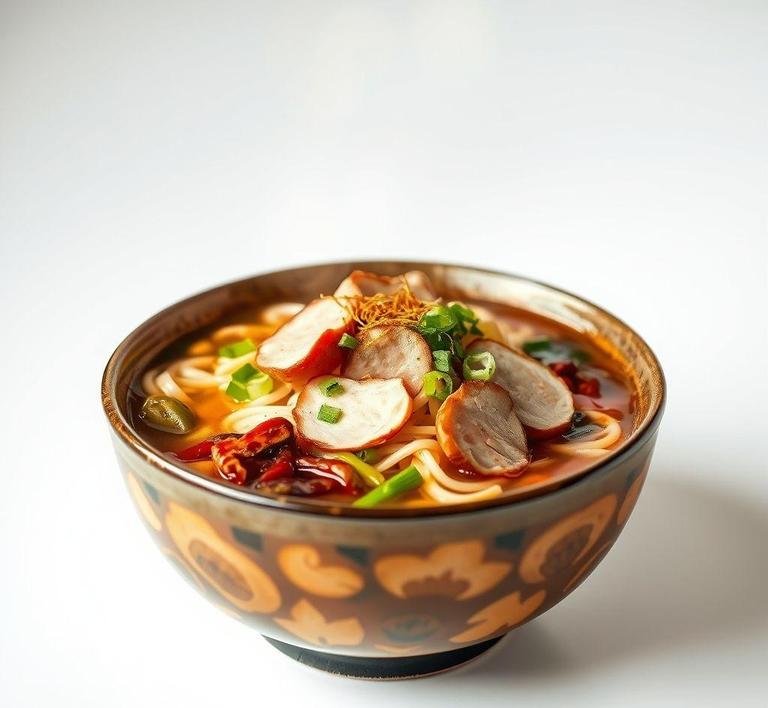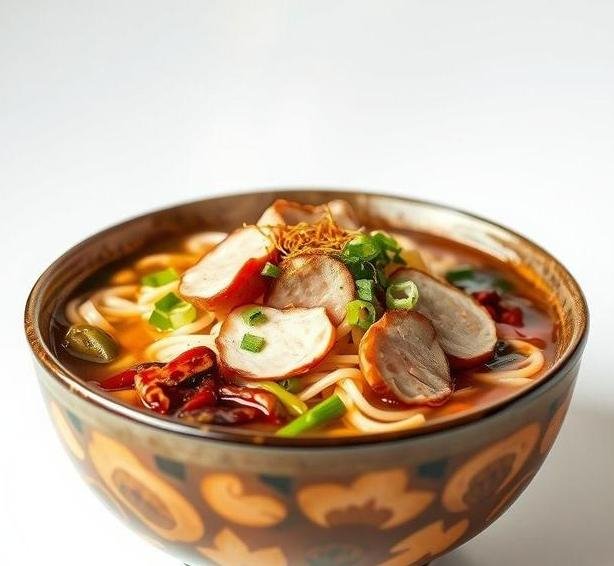Mary Berry, the beloved British culinary icon, is known for her charming approach to cooking and her ability to put a sophisticated twist on traditional dishes. One of her unique and globally-inspired creations is her Japanese Noodle Soup. A delicious fusion of savory, aromatic, and umami-rich flavors, this dish offers a hearty yet comforting bowl that transports your taste buds straight to Japan. The soup is built around the concept of ramen, a Japanese noodle soup that features a deep broth, chewy noodles, and a variety of garnishes and toppings.
Mary Berry’s version, however, strikes a balance between authenticity and accessibility. It’s designed to be approachable for home cooks without sacrificing the delicate flavors that make Japanese noodle soups so beloved. The soup is savory with a rich, umami-filled broth often based on miso, soy sauce, or dashi, paired with slurpy noodles and garnished with an assortment of fresh and flavorful toppings, like spring onions, mushrooms, and sometimes even soft-boiled eggs.
Mary Berry’s Japanese Noodle Soup Recipe
Ingredients Needed

The ingredient list for Mary Berry’s Japanese Noodle Soup is a celebration of Japanese flavors, yet simple enough to be recreated with ease. Here’s a breakdown of what you’ll need to bring this comforting dish to life:
- Ramen Noodles: These are the star of the dish. You’ll want to use fresh ramen noodles if you can find them, but dried noodles will work just fine as well. The noodles are what make this soup a “ramen”, offering that perfect chewy texture that holds up to the broth.
- Miso Paste: Miso paste, made from fermented soybeans, gives the soup its depth and savory umami flavor. There are different types of miso-white (sweet) and red (salty and robust). A mix of both might be used for balance, though the recipe may specify which one to use.
- Soy Sauce: Essential for saltiness and further enhancing the umami profile of the soup. It adds a light, salty complexity that complements the miso paste perfectly.
- Vegetable or Chicken Stock: This is the foundation of the broth, providing liquid and flavor. A rich homemade stock would be ideal, but store-bought stock or even a bouillon cube will work in a pinch.
- Garlic and Ginger: A mixture of finely chopped garlic and ginger adds a warm, aromatic depth to the broth, giving it a fragrant and flavorful backbone.
- Vegetables: Classic toppings for Japanese noodle soup include sliced mushrooms (shiitake or button mushrooms work well), spinach, bok choy, or other leafy greens. The vegetables bring freshness and balance to the dish.
- Spring Onions: These are used both for flavor and as a fresh garnish. They add a crisp, light bite to contrast the richness of the broth.
- Eggs: Soft-boiled eggs are often added to ramen, and Mary Berry’s version is no exception. The runny yolk adds richness and a smooth texture that complements the noodles and broth.
- Sesame Seeds: Optional, but a sprinkle of toasted sesame seeds provides a nice crunch and nutty flavor.
- Chili Oil or Fresh Chilis: For those who like a bit of heat, a drizzle of chili oil or a few slices of fresh chili can elevate the soup to a whole new level of flavor.
Equipment Needed
Preparing Mary Berry’s Japanese Noodle Soup requires a few key kitchen tools to make the process seamless and efficient. Here’s what you’ll need:
- Large Soup Pot or Dutch Oven: This is where you’ll cook the broth and combine all your ingredients. A heavy-bottomed pot is ideal for even heat distribution.
- Medium-Sized Saucepan: If you’re boiling eggs separately, a saucepan is handy. A medium-sized pot will also work well for cooking the noodles.
- Chopping Board and Knife: For slicing vegetables like mushrooms, spring onions, and any other toppings. A sharp knife is essential for precision and ease.
- Strainer or Slotted Spoon: To remove eggs from boiling water or to strain vegetables if needed.
- Ladle: A ladle is perfect for serving the soup and making sure you get all of the delicious broth and toppings into each bowl.
- Serving Bowls: Deep, wide bowls are ideal for ramen-style noodle soups. The wide rim allows for ample toppings, and the deep bowl ensures that there’s plenty of broth to soak up the noodles.
- Egg Timer or Clock: To make sure you cook your eggs to perfection-soft-boiled with a creamy yolk inside.
Instructions To Make Mary Berry’s Japanese Noodle Soup
- Prepare the Broth: In a large soup pot, pour in the vegetable or chicken stock and bring to a simmer. Add the miso paste, soy sauce, garlic, and ginger. Stir well to dissolve the miso, ensuring the broth becomes smooth and fragrant. Let it simmer gently for about 10-15 minutes to allow the flavors to meld.
- Boil the Noodles: In a separate saucepan, bring a pot of water to a boil. Add the ramen noodles and cook according to the package instructions, usually 3-5 minutes. Once cooked, drain the noodles and set them aside.
- Soft-Boil the Eggs: Gently place the eggs in boiling water for about 6-7 minutes for soft-boiled eggs with a slightly runny yolk. Afterward, transfer the eggs to a bowl of ice water to stop the cooking process. Peel the eggs carefully once cooled.
- Assemble the Soup: Once your broth is ready and the noodles and eggs are prepared, it’s time to assemble the soup. Place a portion of the cooked noodles into each bowl. Pour the hot broth over the noodles, making sure to cover them fully.
- Add Toppings: Arrange the sliced mushrooms, spinach, bok choy, and spring onions on top of the noodles. Halve the soft-boiled eggs and place them on top as well.
- Garnish and Serve: Finish by sprinkling sesame seeds and a drizzle of chili oil or fresh chili slices, if desired. Serve immediately, while hot, and enjoy!
Tips And Tricks
- Miso Balance: If you’re not familiar with the taste of miso, start with a smaller amount and taste-test the broth as it simmers. Miso can vary in saltiness and intensity, so adjust according to your preference.
- Customizable Toppings: Don’t be afraid to get creative with toppings! If you can’t find bok choy or spinach, try using other greens like napa cabbage or even kale. You can also add a variety of proteins, like shredded chicken, pork belly, or tofu.
- Perfecting Eggs: If you prefer your eggs less runny, cook them a bit longer-around 8-9 minutes for a more firm yolk. For an extra decadent touch, marinate the soft-boiled eggs in soy sauce and mirin for a few hours before adding them to the soup.
- Noodle Texture: For chewy, authentic ramen noodles, try to use fresh ramen if possible. If using dried noodles, make sure to not overcook them, as they can become mushy when added to the hot broth.
- Make Ahead: The broth can be made ahead of time and stored in the fridge for a few days or frozen for longer storage. Just reheat it gently before serving, and cook the noodles fresh.
Mary Berry’s Japanese Noodle Soup offers a delightful introduction to the world of Japanese ramen with an easy-to-follow recipe that’s perfect for home cooks. This dish is a wonderful combination of rich umami flavors, tender noodles, and fresh, vibrant vegetables that come together in a satisfying and comforting meal. Whether you’re seeking a hearty lunch, a dinner to impress guests, or simply something to warm you up on a chilly day, this soup ticks all the boxes.
By following the simple steps, using fresh ingredients, and adding your personal twist with toppings, you can recreate the vibrant and savory experience of a traditional Japanese noodle soup right in your own kitchen. So, gather your ingredients, roll up your sleeves, and get ready to enjoy a bowl of flavor-packed goodness.
Easy Recipe Variations For Mary Berry’s Japanese Noodle Soup

Mary Berry’s Japanese Noodle Soup is a flavorful dish inspired by traditional Japanese ramen, often brimming with a savory broth, fresh noodles, and various toppings. But like any great recipe, it leaves room for personal twists. Here are some easy variations you can try to customize this dish and make it your own:
1. Vegetarian Option
For those looking for a meat-free alternative, Mary Berry’s soup can easily be adapted to a vegetarian version without sacrificing any of the rich flavors. Replace the traditional pork or chicken with a mix of sautéed mushrooms like shiitake, portobello, and enoki. These mushrooms add umami depth to the soup, and their earthy flavors complement the broth perfectly. Add tofu or tempeh for protein, and don’t forget to toss in extra greens like spinach or bok choy for added nutrition. For a more authentic touch, substitute the chicken broth with a vegetable or miso-based broth.
2. Spicy Ramen
If you’re someone who loves a bit of heat, you can kick up the spice level in Mary Berry’s Japanese Noodle Soup by incorporating chili oil or paste into the broth. A tablespoon of sriracha, gochujang (Korean chili paste), or chili flakes can easily elevate the flavor. For an extra fiery kick, add sliced fresh chilies like bird’s eye chili or jalapeño. A dash of sesame oil paired with chili oil will give the soup a smoky, spicy depth, and a squeeze of lime at the end can add a zesty contrast.
3. Seafood Twist
While Mary Berry’s recipe often calls for chicken or pork, why not switch things up with seafood? Shrimp, mussels, or even fish like cod or salmon can add a wonderful lightness and a touch of the sea to the soup. Shrimp, when gently poached in the broth, takes on a tender, succulent texture that complements the noodle’s chewiness. If you opt for mussels or clams, their briny sweetness will add a wonderful contrast to the salty broth. Simply drop them in during the last few minutes of simmering so they cook through without becoming tough.
4. Broth Variations
The broth is the heart and soul of any noodle soup, so why not play around with its base? You could swap out the traditional chicken stock for a beef broth for a richer, more robust flavor. For a smoky undertone, use a bit of smoked soy sauce or add a few dried seaweed sheets (kombu). If you love a more complex flavor profile, try adding miso paste or even a spoonful of peanut butter to the broth for an unexpected depth of flavor. Alternatively, if you’re craving a lighter, fresher taste, opt for a clear, chicken-based broth with a squeeze of lemon juice to brighten things up.
5. Topping Customizations
No Japanese noodle soup is complete without the right toppings, and these can make or break your dish. Traditional toppings like a boiled egg, nori seaweed, and green onions are a must, but there are many other options to explore. Add crispy fried onions or garlic chips for an extra crunch. You can also try pickled ginger for some zing, or add a few slices of avocado for richness. For some contrast, a sprinkle of toasted sesame seeds or a handful of fresh cilantro can balance the flavor, while also adding some visual appeal. Don’t forget about the perfect soft-boiled egg-its silky yolk adds a luxurious touch to the dish.
6. Gluten-Free Option
For those on a gluten-free diet, the noodles are the main obstacle in making this soup. You can easily find gluten-free ramen or soba noodles made from rice or buckwheat flour. Alternatively, zucchini noodles or rice noodles work well as a substitute. Be sure to check that the soy sauce you use is gluten-free (tamari is a great option), and consider using gluten-free miso if you’re adding it to the broth. With these simple substitutions, you can still enjoy a bowl of Japanese noodle soup that fits your dietary needs.
Storing Leftovers
Leftovers of Mary Berry’s Japanese Noodle Soup can be a delight, but it’s important to store them properly to maintain the best flavor and texture. Here are some tips for storing and reheating the soup:
1. Storing The Broth And Noodles Separately
If you plan on storing leftovers, it’s best to separate the broth from the noodles. Noodles tend to absorb liquid over time, and if stored together, they may become mushy. Store the noodles in an airtight container and refrigerate them for up to 2 days. The broth can be stored in a separate container for up to 3 days in the refrigerator. When reheating, simply warm the broth on the stove, and add the noodles back in for the last few minutes to heat through.
2. Freezing Leftovers
If you have more leftovers than you can eat in a few days, freezing is a good option. Again, it’s ideal to freeze the broth and noodles separately. The broth freezes well in an airtight container or freezer-safe bag for up to 3 months. When you’re ready to eat it, defrost the broth overnight in the fridge and reheat it on the stove. For the noodles, they can also be frozen but may lose some texture when reheated, so it’s best to store them with the intent to eat them within a few weeks.
3. Toppings
Toppings like soft-boiled eggs, mushrooms, or greens generally don’t store well, as they can wilt or change in texture. For the best results, store them separately and add fresh toppings when reheating your soup. A fresh egg, a handful of chopped spring onions, or a few sheets of nori can transform your reheated bowl into something special.
What To Eat With Mary Berry’s Japanese Noodle Soup?
While Mary Berry’s Japanese Noodle Soup is a meal in itself, it pairs beautifully with a variety of sides and accompaniments to enhance the experience. Here are some ideas for what to serve with it:
1. Japanese Gyoza
Gyoza (Japanese dumplings) are a perfect side dish to pair with noodle soup. Their crispy exterior and savory filling provide a wonderful contrast to the lightness of the broth. You can find pre-made gyoza in many grocery stores, or make your own with ground pork or chicken, cabbage, and ginger. Dip them in a simple soy-based sauce for an extra burst of flavor.
2. Edamame
Edamame, young soybeans, are a healthy and satisfying appetizer or side dish. Simply steam or boil them and sprinkle with sea salt. They’re crunchy, salty, and high in protein, making them an excellent complement to the light broth of the Japanese noodle soup. For added flavor, try tossing them in sesame oil or a dash of soy sauce before serving.
3. Japanese Pickles (Tsukemono)
Japanese pickles, or tsukemono, are a common accompaniment to many dishes, including noodle soup. Their tangy, crunchy texture provides a great contrast to the soup’s warm, savory broth. You can find a variety of tsukemono at Japanese markets, ranging from pickled cucumbers to pickled radish (takuan) or pickled plums (umeboshi). Their acidity helps cleanse the palate between spoonfuls of rich broth.
4. Rice Balls (Onigiri)
For a more substantial meal, rice balls (onigiri) are an ideal choice. Onigiri are simple to make by shaping cooked rice into triangles or balls, often with a filling like umeboshi (pickled plum) or tuna mayo. The salty, vinegary flavors of the rice balls pair wonderfully with the Japanese noodle soup, providing a different texture and extra bite to the meal.
5. Miso Soup
If you’re craving more soup, a small bowl of miso soup makes an excellent side. Its umami-packed broth and soft tofu cubes are complementary to the noodles, giving you a fuller Japanese dining experience. Add some wakame seaweed and green onions for extra flavor.
Conclusion
Mary Berry’s Japanese Noodle Soup is a deliciously comforting dish that offers plenty of room for creativity, whether you’re customizing it to suit your taste or making it your own with variations in broth, toppings, and proteins. Whether you’re choosing a vegetarian option, craving something spicy, or experimenting with a seafood twist, there are endless ways to put your personal spin on this already delightful recipe. Storing leftovers properly ensures you can enjoy the soup for days to come, and pairing it with sides like gyoza, edamame, or onigiri elevates the experience, making it a full, satisfying meal. Whether you’re cooking for a family dinner, meal prepping, or indulging in a solo bowl of comforting soup, Mary Berry’s Japanese Noodle Soup is a versatile dish that’s always a crowd-pleaser.
FAQs
What Ingredients Are Required For Mary Berry’s Japanese Noodle Soup?
Mary Berry’s Japanese Noodle Soup recipe typically calls for a range of fresh and flavorful ingredients including Japanese noodles (such as soba or udon), soy sauce, miso paste, sesame oil, and fresh vegetables like spring onions, mushrooms, and spinach. Additionally, it may include a protein such as chicken, tofu, or prawns, depending on personal preference. The dish is seasoned with ginger, garlic, and a little mirin to balance the umami flavors.
How Long Does It Take To Prepare And Cook Mary Berry’s Japanese Noodle Soup?
The preparation time for Mary Berry’s Japanese Noodle Soup is approximately 20 minutes, as it involves slicing vegetables and prepping the protein (if using chicken or tofu). The cooking process takes another 10-15 minutes, making the total time around 35-40 minutes from start to finish. It’s a relatively quick recipe, perfect for a midweek meal or a flavorful lunch.
Can I Make Mary Berry’s Japanese Noodle Soup Vegetarian Or Vegan?
Yes, Mary Berry’s Japanese Noodle Soup can easily be made vegetarian or vegan. Simply replace the chicken or prawns with tofu or tempeh as a protein source. Ensure that you use a vegetarian or vegan-friendly miso paste (some miso pastes contain fish products), and choose plant-based noodles if necessary. You can also omit any non-vegan toppings and use vegetable stock instead of chicken stock to keep it completely vegan.


